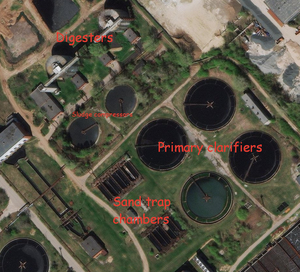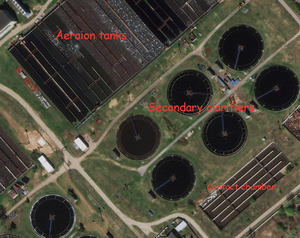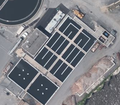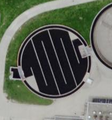Proposal talk:Process tanks
Man_made is (too) obvious
This proposal is a good opportunity to get a more precise description of some water works equipment and it's great.
I find man_made=* too generic to get values as proposed. Shouldn't we choose a more precise term, according to your rationale? water_works=* sounds to be already took for facilities (with man_made=water_works), I'm still looking for a similar term for devices.
However I'm sure you'll find relevant points to change my mind Fanfouer (talk) 23:41, 8 March 2021 (UTC)
- I also dislike how overloaded man_made=* is. One possibility I thought of is man_made=storage_tank, but these are not storage tanks -- they're doing processing. The tag water_works=* seems like it would be for describing the type of water works, and not for objects within it. Another possibility is to define a single tag within man_made=* to generally describe water processing elements, and then additional specific keys to say whether it's a clarifier, oxidation ditch, aerator, etc. I'm not quite sure what to call that. I'd be very interested in thoughts you might have to better organize these objects, especially since they are just two of what are likely multiple values. --ZeLonewolf (talk) 23:59, 8 March 2021 (UTC)
- But this is in common with man_made=wastewater_plant. ---- Kovposch (talk) 19:26, 9 March 2021 (UTC)
- As variant, man_made=wastewater_pond + wastewater=clarifier/oxidation_ditch Something B (talk) 21:50, 10 March 2021 (UTC)
Our current thinking is to have man_made=processing_tank be the top-level tag, and then describe the specific type of processing tank with sub-tagging, such as processing_tank=clarifier, processing_tank=oxidation_ditch, etc. This would specifically address those features that are in a man-made tank form factor; we realize tagging is still needed for settling/aeration basins. --ZeLonewolf (talk) 21:53, 10 March 2021 (UTC)
- I have thought of chemical "reactor" (not nuclear reactors) in terms of the scientific model language (plug-flow, completely mixed, continuously stirred reactor, etc). Yet I wonder whether man_made=processing_tank is still too broad, as in whether other liquid-solid mix (eg fermentation tank) or even purely solid and air content "processing tanks" may count. The ambiguity of "processing" also mixes up chemical reaction (aeration) with physical change (clarifier) here. ---- Kovposch (talk) 05:25, 11 March 2021 (UTC)
- Well, "reactor" would definitely be a confusing term, I think! Looking at the other values in man_made=*, I'm thinking it's the right level of specificity, and yes, I think it would be fine to have it broadly cover a wide variety of processing. As far as I know there aren't competing schemes for this. --ZeLonewolf (talk) 13:27, 11 March 2021 (UTC)
- Well man_made=processing_tank would be consistent with man_made=storage_tank. Without no further and better proposition, this one sounds good :) Fanfouer (talk) 21:37, 11 March 2021 (UTC)
- Then how about eg man_made=reaction_tank? Emphasizes a (chemical) reaction happens. Noticed now "processing tank" can be a term specific to septic tanks for recirculation. Statistically, Google Search and Google Scholar appears to return ~3x and ~10x results respectively querying "reaction tank" over "reaction tank" within "treatment plant". ---- Kovposch (talk) 22:47, 11 March 2021 (UTC)
- If you still want process*, "process tank" would be a much more common term. No man_made=process_tank instance either yet, though anecdotally there's a name=Biologic Treatment Process tank. ---- Kovposch (talk) 22:51, 11 March 2021 (UTC)
- You're right, process tank does seem to be a term in use. --ZeLonewolf (talk) 02:17, 12 March 2021 (UTC)
- Well, "reactor" would definitely be a confusing term, I think! Looking at the other values in man_made=*, I'm thinking it's the right level of specificity, and yes, I think it would be fine to have it broadly cover a wide variety of processing. As far as I know there aren't competing schemes for this. --ZeLonewolf (talk) 13:27, 11 March 2021 (UTC)
- The man_made=process_tank tag is good idea. Something B (talk) 10:43, 15 March 2021 (UTC)
Use of building key
I've updated the proposal to describe process tanks (the aeration countent is coming), but using the building=* key. How do people feel about this? The advantage is it keeps the same rendering for the 1000 or so objects already tagged in this way and gives out of the box rendering. Otherwise, we are asking people to re-tag features which render today. There are a few values in building=* that do not have roofs, such slurry pits and stadiums, so it does not seem like the presence of a roof is a hard requirement. What are people's thoughts on this? --ZeLonewolf (talk) 03:50, 17 March 2021 (UTC)
- Aside from what I chatted about on Discord, building=grandstand as an example is not exactly a fit. There are usually rooms and stalls underneath/inside it, making it function like a proper building with seating above. Often the top level has rooms for control, announcements, and broadcasting. It and leisure=bleachers are quite messy. ---- Kovposch (talk) 07:06, 17 March 2021 (UTC)
- You are referring to building=digester for "the 1000 or so objects already tagged in this way", not really treatment tanks? Proposed_features/Clarifiers_and_Oxidation_Ditches#Rationale 8 is misleading without comparing man_made=storage_tank ---- Kovposch (talk) 07:14, 17 March 2021 (UTC)
- I think this is a bad idea. These structures are not buildings. All buildings have a roof, but process tanks do not. Something B (talk) 08:23, 17 March 2021 (UTC)
- To be pedantic, building=ruins doesn't necessarily have a roof, but I think you have a point. Incidentally, building=slurry_tank has a note at the top protesting the use of the building=* key for something that is only sometimes covered (with something that probably wouldn't be described as a roof). – Minh Nguyễn 💬 04:51, 19 March 2021 (UTC)
- To be fair, https://wiki.openstreetmap.org/w/index.php?title=Tag:building=slurry_tank&type=revision&diff=2127507&oldid=2127492 is added by User:Something B. ---- Kovposch (talk) 05:17, 19 March 2021 (UTC)
- To be pedantic, building=ruins doesn't necessarily have a roof, but I think you have a point. Incidentally, building=slurry_tank has a note at the top protesting the use of the building=* key for something that is only sometimes covered (with something that probably wouldn't be described as a roof). – Minh Nguyễn 💬 04:51, 19 March 2021 (UTC)
- Yes, I added this note. IMHO, such things are far from buildings in the usual sense. Something B (talk) 21:11, 19 March 2021 (UTC)
Digesters?
Would the Newtown Creek Wastewater Treatment Plant's digester eggs be building=digester or man_made=process_tank or man_made=storage_tank? Presumably the adjacent clarifier ditches would be man_made=process_tank under this proposal. Marcel.dejean (talk) 13:54, 28 March 2021 (UTC)
- During the drafting of this proposal we had a debate about whether or not process tanks could use the building=* key in the general case, and we decided that it doesn't work because a key definition of buildings are that they have roofs. As you note, there is already the existing tag building=digester which has some use. In order to keep the topic narrow, we chose to limit the scope to the general tagging for process tanks and these three specific features (clarifier, oxidation ditch, and aeration tank) which are not well described by existing tagging and easily identifiable in imagery. We welcome the creation of additional values of process_tank=* to be created under the concept of any tags you like or through the proposal process if mappers feel they are appropriate.
- We are not proposing to deprecate building=digester in favor of something like man_made=process_tank + process_tank=digester, however, this tagging could be a good fit. Since there is existing tagging for digesters, creating new tagging risks the creation of a duplicate tagging scheme which may prove controversial. However, if mappers feel that tagging digesters as process tanks is appropriate, either in combination with building=digester or as standalone tagging, of course they are welcome and encouraged to do so. --ZeLonewolf (talk) 03:30, 2 April 2021 (UTC)
Some notes
- I do not think that we should mark as "not recommended" natural=water + water=wastewater. The natural=water tag currently has clear for anyone (who does not know details of wastewater processing) meaning: "every open water surface can be marked with it". There is no matter, does it have natural or artificial origin - for example, water=pond or water=basin in most cases are made by people and even have regular geometry (and the last one is dry most part of time).
- (replying separately to each section) Regarding your note that "every open water surface can be marked with it", consider that swimming pools (leisure=swimming_pool) would not be correctly tagged natural=water. Similarly, I think that open tanks (whether storage tanks or process tanks) are a separate class of object from general open water bodies, and closed tanks would definitely not be tagged as a water body. If a mapper looks at a tank and says "I don't know what it is, but it is something to do with wastewater" and tags it natural=water+water=wastewater, then it is no problem that someone comes along later to tag it as a tank. I will note that tanks (storage tanks) in the default OSM style render in a building style (tan/gray colored) while natural=water renders as blue. So, it is clear that renderers treat tanks as a wholly separate class of object from water and therefore it is important to make a recommendation to mappers that do identify these objects as tanks and to tag them either as one or the other so that there isn't ambiguity as to which class of object it belongs to. Would you suggest a different recommendation or tagging combination? --ZeLonewolf (talk) 03:44, 2 April 2021 (UTC)
- "tanks (storage tanks) in the default OSM style render in a building style (tan/gray colored) while natural=water renders as blue" - that's right. But if speaking about clarifiers, it seems that open clarifiers are looks like more than water bodies rather than buildings on the aerial imagery & on the ground. At least they don't have roof. If we talk about covered clarifiers - I agree that for them natural=water+water=wastewater seems to be not applicable well, they may be tagged as building also. So I think we shouldn't declare hard link between presence of man_made=process_tank tag and absence of natural=water/building=storage_tank tags. They can co-exist easily on the same object, depending on its construction AnakinNN (talk) 10:26, 7 April 2021 (UTC)
- @ZeLonewolf: Could you add some aerial photography to the proposal page that show objects that should keep the natural=water+water=wastewater tagging? Would these be found somewhere nearby or within wastewater plants? I can't really figure out the distinction between those and your proposed storage tank tag suggestions.--Kjon (talk) 09:40, 5 June 2021 (UTC)
- It seems the only difference between process_tank=aeration and process_tank=oxidation_ditch is the flow direction, but essentially they are the same. For example, oxidation ditch in the wastewater plant in Moscow (from the proposal examples) is officially called Experimental aerotank section with circular wastewater flow. Don't you think that both will better be tagged as process_tank=aeration with the flow shape separated to another special tag?
- My understand (and please correct me if I'm wrong about this) is that an aeration tank does not provide flow, while an oxidation ditch does. While of course these could be grouped together, since there are two major form factors (standing aeration tank and flowing oxidation ditches) I felt it would be easier for mappers to have distinct tags for each type since they are so distinctive in imagery, and that this would be less confusing than an additional tag to indicate the type of flow. --ZeLonewolf (talk) 00:10, 3 April 2021 (UTC)
- All aeration tanks (at least that working with active sludge technology) provide flow - water must somehow move from primary clarifiers to aerotanks and then from aerotanks to secondary clarifiers. These tanks can be either built on at slightly different altitudes, when flow is reasoned by gravity, either special pumps are installed AnakinNN (talk) 10:26, 7 April 2021 (UTC)
There are also some kinds of wastewater processing tanks, which are not covered by current version of proposal:
- Sludge compressor looks like clarifier, but there is no separation processes in it. Instead, it compresses redundant sludge (which arrives from aerotanks) for further transfer to digesters (or some other facility of plant).
- Sand trap chamber looks like aeration tank, but without turbulence. Wastewater just flows through it (just after entering wastewater plant), and while it flows, sand and other mineral contaminations settle to the bottom of chamber.
- Contact chamber is the place, where cleaned wastewater is being contacted with the chlorine for final decontamination. No air compression is being made while processing.
- Also clarifiers are divided into primary and secondary. Wastewater comes to the primary ones before being processed in the aeration tanks and to the secondary ones - after aeration tanks.
 
|
It will be great to reflect all these aspects in the proposal. Maybe we'll need more intuitive and common definitions rather than I've bolded - this is just translated of original russian definitions from official technical report about city wastewater processing in Nizhny Novgorod, Russia --AnakinNN (talk) 20:43, 28 March 2021 (UTC)
- @AnakinNN: Thank you for these examples. I do agree that these three objects that you describe do fit within the definition of process tanks. The reason we didn't include other types of objects are that we didn't have enough knowledge of what they looked like in order to describe them properly and give practical advice to mappers as to what they look like, but I do support their inclusion. I think the vast majority of mappers will struggle to identify these objects properly without a really good set of example images! The contact chambers we could probably describe quite nicely. Do you think you could come up with a few more sludge compressor and sand trap examples? That would help us (the authors) make sure that we are identifying these properly. --ZeLonewolf (talk) 00:30, 3 April 2021 (UTC)
- My point was that it's a little hasty to detect type of process tank with relying only on aerial imagery. At first I thought that sludge compressors have smaller radius than clarifiers, but on the Kuryanovskaya aeration station in Moscow there are sludge compressors of even larger size (this 4 ones; they're covered after recent reconstruction, but of you switch imagery to ESRI at top right corner, you'll see older image where they are with open water surface; multiple round tanks at right are clarifiers, and rectangular ones further are aerotanks). As I mentioned above, aerotanks also can have rounded form, not rectangular only. Contact chamber on satellite imagery can be hardly distinguished from the sand trap chamber and so on. I suggest to use not very strict phrases like "in most cases clarifiers/aerotanks may be detected by ...", and we should necessary mention that in case of presence open technical documentation checking out with it is the best way to know exact purpose of every individual tank AnakinNN (talk) 10:26, 7 April 2021 (UTC)
Collection of examples
Contact chamber
Contact chamber at the Florham Park
 Florham Park treatment plant, New Jersey, USA
Florham Park treatment plant, New Jersey, USA
Contact chamber at the Delcora Wastewater Treatment Plant
 Delcora Wastewater Treatment Plant, Pennsylvania, USA
Delcora Wastewater Treatment Plant, Pennsylvania, USA
Irregularly-shaped Contact chamber at the Athlone Waste Water Treatment Works
 Athlone Waste Water Treatment Works, South Africa
Athlone Waste Water Treatment Works, South Africa
Contact chambers at Пречиствателна станция за отпадни води
 Пречиствателна станция за отпадни води, Bulgaria
Пречиствателна станция за отпадни води, Bulgaria
Circular baffled tank at the Greater Mentor Wastewater Treatment Plant
 Greater Mentor Wastewater Treatment Plant, Ohio, USA
Greater Mentor Wastewater Treatment Plant, Ohio, USA
Deprecate some mentioned tags within this proposal?
Would it make sense to formally discourage/deprecate the use of some of the mentioned existing tags within your proposal? The following tags come to mind reading their current descriptions:
--Kjon (talk) 11:53, 7 April 2021 (UTC)
Introduce process=* instead of new top level tag
I don't see any added value for OSM to make a new top-level value for process tanks.
As an engineer, I can say that any process tank, depending on the stage in the process, is a storage tank. Even if you would take into consideration, that due to what appliances it has or how it is build, doesn't give you a clue of whether it is used as a process tank or just a storage tank.
Many storage tanks need a "process" to keep it's contents "unchanged".
Some examples:
- A liquid with suspension of some solids needs to be stirred during storage to maintain the suspension. If not you get flocculation, clogging ,sedimentation. Other fluids might need heating to maintain the stored substance in it's desired state, heating being a "process".
- Fuel tanks might have nitrogen blanketing to prevent explosive evaporation damps or oxidisation by air. Still, they remain storage tanks but removing the "conservation processes" will result of the input not being the same as the output (not in chemical and not in physical characteristics).
- Pumped ground water with high iron content will oxidise when exposed to air, changing it's odour, causing discolouring and even flocculation. When it is "stored" without some kind of preservation or conservation measures in place, what went in will not be the same of what came out. Same with bacterial growth in water storage tanks. All these preservation or conservation measures are processing which many time takes place in the storage tanks. Hard to distinguish or classify them as "process" tanks.
Many get disused for, primarily processing, others don't. Especially in water sewage facilities it is often difficult, even for me as an engineer, if it is still in use as a process tank, intended to be a process tank (because some storage tanks we just add f.i. an aerator and it becomes a process tank ?). Now you expect that this tag is going to solve this problem, an issue where even experts disagree many times.
A tank is just a tank, add some attributes to it if you are sure and have seen proven that it is used for more then just storage, then add attributes to it like in a process=* tag. Essentially nothing is wrong to keep it under other top level tags, being it water=reservoir, basin or pond or man_made=storage_tank. They all can become a process tank somewhere in the processing of the fluid, they all are just storage tanks in some stage of the processing. Keep it simple.
Process tanks, or as I might say storage tanks with or without some kind of process, appear in many more other facilities then just sewage plants. This proposal is to specific for just sewage facilties.
Storage tanks can be used for processing at some point in time the same applies to reservoirs and basins. Adding an attribute key process=* could be used with all of them in a consistently.
OSM should be usable and accessible by mappers without the need for specific chemical, process or engineering knowledge or knowledge of water treatment facilities.
--Bert Araali (talk) 16:54, 10 April 2021 (UTC)
- @Bert Araali: we've been discussing something along these lines, and we recognize the adoption benefit in crafting extensions to existing tags which already render in the default rendering (and are thus generally supported by data consumers). While the motivation for this proposal was related to water treatment, we recognize the need to craft tagging which can be applied just as equally to a brewery or a refinery, etc. To do as you suggest, we would have to expand the currently-documented usage of man_made=storage_tank to cover these classes of objects (which do not presently appear to fall within those definitions). The thought of creating tagging that can apply to not just tanks but other fluid-containing features such as basins is an interesting idea. In the water treatment plant nearest to me there is a (pond? basin?) with fountain aerators, constructed with earthen banks. Since it's a dug out hole in the ground, I wouldn't describe it or tag it as a tank, but it would be nice to be able to say "this basin/pond has an aerator in it" in a generic way.
- We are wrestling with whether to define tagging based on the type of tank or the type of processing. For example, a secondary clarifier at a water treatment plant could be something like:
- This would allow someone that knows little about the plant to simply recognize it as a tank and tag it man_made=storage_tank. Further, someone that looked at the wiki documentation for clarifiers might recognize it by the imagery and add storage_tank=clarifier, while someone with deep expertise in water treatment facilities might later add clarifier=secondary.
- Alternately, we could take a functional approach with tagging. A not-serious example for tagging a clarifier might be something like:
- The problem with this line of thinking is this fails the "duck test" for something clearly recognizable with a common name "clarifier". Taking a different approach with your proposed "process" key might look something like this:
- I'm not sure that's quite the right scheme as "clarifier" isn't a "type of process", but you get the idea. One of the goals on this proposal is that "duck test" features, i.e., objects that have a standard real-world name can have a tag with that name, i.e., a clarifier should be tagged with a value of clarifier to keep it simple for mappers.
- Perhaps we might even consider a hybrid approach, where "duck test" features have their own tag, while specific processing functions can also be tagged orthogonally. So you could have something like a process=aeration (or perhaps process:aeration=yes) tag that indicates a feature has an aerator while still keeping specific tags for clarifiers and oxidation ditches which are easily and simply identified as a distinct type of object.
- I welcome further thoughts you might have, particularly if you have specific suggestions as to how real or hypothetical features might be tagged. --ZeLonewolf (talk) 23:53, 10 April 2021 (UTC)
- @ZeLonewolf: thanks for the clarifications and apologies for the delayed reply, I needed some time to overthink the concept.
- The example you given, process=clarifier is not a process, it's an equipment type. Different processes can take place in the equipment, so I would propose to use equipment=clarifier. If the equipment has a specific name one can use name=*, often they have a reference you use ref=*. Mappers hould only map them if it is clearly visible what the equipment is, by f.i. a tag or nameplate on the equipment. One should not make conclusions from satellite imagery only, as it cannot be decisisive to determine if the equipment is actually still in use as a process equipment or just as storage (the ground truth).
- Does it make sense to describe the process(es) that take place in the equipment ? In my opinion not, the variety is so large and can hardly determined without specific knowledge, engineering, construction and process knowledge. Knowledge which most OSM users won't have, neither can it be conclusive from what you see on the ground, as I stated before, even for an engineer this can be tricky. A solution could be, if the specialised knowledge is avaible and public (many processing facilities don't make their specific processes public, so be careful) I would suggest to use wikidata. It allows more referencing, is more suitable and easier to query then our OSM data. The process data is anyway not geographical data or verifiable ground truth, so doesn't belong in OSM. Wikidata has better facilties to reference other data sources for detailed process descriptions.
- All of the tags should be attribute tags of top-level tags, so the same concept can be used on all industrial facilities.
- So for sewage plants this might be man_made=storage_tank or natural=water with water=reservoir. Now the reservoir might have more specific type information with reservoir_type=* but that should not be ambiguous with the equipment=*. For example a reservoir_type=water_storage can perfectly be equipped with pumps, aerators, a skimmer etc..., preprocessing like flocculation and coagulation may take place, scum be removed by a mechanical skimmer... however out of service. So still, if it's tagged or signposted in the field as "clarifier" it gets the name=* and equipment=clarifier, because you can't determine if it's permanently out of service or just short term. In less developed and automated facilities these processes might be taken place manually (there is no visible equipment present), but still it is in the field marked, signposted or tagged as a clarifier, so should be tagged the same name=* and equipment=clarifier. If you have detailed public information you add wikidata=* where you add the processes with references to their respective Wikipedia or other data source descriptions of the processes.
The same can be applied to all other industrial processing equipment, either storage or specific for processing which we already have, so can be used to add tagging for processing buildings, tanks, silos, etc... . All verifiable, ground truth for common OSM users.
- I like this better then what you propose as clarifier=secondary, as it is more clear and introduces an attribute tag which can be used in combination with many top-level tags, without introducing a large variety of specialised keys for the equipment types.
- If I take into account your functional proposal, we both are on the same page, process:skimming=yes or process:settling=yes is not appropriate. You introduce values in keys and then use them as booleans, very bad practice and difficult to query. The functional proposal in my idea is accessible through wikidata, as mostly it can't be determined by just ground truth, so it doesn't belong in OSM. WIkidata with it's triplets structure is more suitable. So functional tagging makes sense with wikidata=*, and it passes the duck test with equipment=*, name=* and ref=*.
- All tanks should be tagged with man_made=storage_tank, as I said before, they all are just for storage in some point of the processing cycle. I see no problems with semantics there. The same tags can be used for other industrial equipment ranging from pumps to generators, compressors, fans, columns, silos, conveyors etc.... For some of these we have specific tags, others might need an additional tag, which could be in combination with equipment=*, something like man_made=factory or man_made=works, mapped as
 or
or  or
or  and tagged with appropiate equipment=*. Even equipment grouped in buildings on industrial sites can be used with the building=industrial. In these cases the building might have a different name from the equipment, so in that case one could use name:building=* and name:equipment=*, but this needs some more detailed study.
and tagged with appropiate equipment=*. Even equipment grouped in buildings on industrial sites can be used with the building=industrial. In these cases the building might have a different name from the equipment, so in that case one could use name:building=* and name:equipment=*, but this needs some more detailed study.
To me the most important in this is that we exclude non-verifiable data from OSM, but use wikidata if specific data is avaibale from external sources, to be added by mappers with specific knowledge through wikidata. Adhering to the basic principles of OSM.
Happy to hear you're thoughts about this.
--Bert Araali (talk) 14:08, 27 April 2021 (UTC)
- Is there anything bad with man_made=storage_tank + process_tank=* (or similar) then? equipment=* sounds like a individual piece of equipment in the treatment tank's system, like a scoop or chemical dosing; more than indicating it has or is performing as a certain "equipment". ---- Kovposch (talk) 17:55, 5 May 2021 (UTC)




